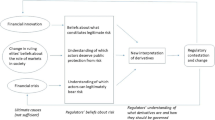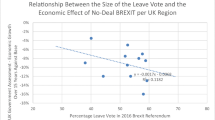Abstract
In this paper, we investigate how the extraterritorial applicability of the US over-the-counter derivatives regulation impacts the off-balance sheet positions of foreign branches of US banks. While existing research has focused on the effects of the regulation on swap markets’ liquidity, we contribute to the literature by looking at off-balance sheet exposures, focusing on geographically disaggregated data. Swaps exposures are found to increase in those jurisdictions in which limited extraterritoriality applies due to the substitute compliance framework. Furthermore, we find an increase in futures and forwards exposures in foreign branches located in host countries that fully comply with the extraterritoriality. Our results are consistent with a geographical and cross-product regulatory-induced activities reallocation.
Similar content being viewed by others
Notes
Title VII, Sect. 2(i)3, details the criteria according to which extraterritorial applicability applies. The following are considered: the features of institutions affected (i.e., definition of a US person), the treatment of guaranteed conduits and affiliates, the type of rules extended abroad and the framework for substituted compliance. The mandate is centered on two different levels of rules for OTC derivatives: entity and transaction based. Entity-based rules deal mainly with registration of Swap Dealers and Large Swaps players, data repository requirements and capital requirements. Transaction-based rules include items such as margin requirements, as well as clearing and trading reporting.
Sources: FFIEC and Bank of International Settlements, BIS, (2006-end data).
See McDonald and Paulson (2015) for a detailed account of the AIG crisis and bailout.
These statistics refer to end-2014 figures and are based on a sample of foreign branches filing the FFIEC030 form. Consolidated balance sheet figures for US banks were obtained by the US flow of funds publication (Table L.111).
Notional values should be interpreted with care as they do account for actual risk exposure. Unfortunately, netted exposures for off-balance sheet financial instruments are not reported in the FFIEC030 dataset.
Some studies have looked at the effect of the DFA on US banks’ on-balance sheet activities. Hogan and Burns (2019), for instance, find a post-DFA increase in noninterest expenses experienced by US banks, due to regulatory compliance.
The extraterritorial feature of the reform has raised a number of concerns in the international regulatory debate. Barnier (2013) and Dallara (2013) argue that the extraterritorial application of Title VII may result in conflicts, discrepancies, and regulatory duplication, which would weaken the effectiveness of the regulation not only in the US but also abroad.
See Howell (2015) for a throughout discussion on the rationales behind the substitute compliance frameworks used by US regulators.
Efforts to globally coordinate OTC derivatives were explicitly set by the G20 leaders at the 2009 St. Petersburg summit.
The EC has recognized requirements equivalence through three subsequent implementing acts: in October 2014 for Australia, Hong Kong, Japan and Singapore; in November 2015 for Canada, Mexico, South Korea, South Africa and Switzerland; and in March 2016 for the US. Although the implementing acts were released by the EC in 2014 and 2015, technical reports on equivalence for central counterparties regulations for these countries were available in the third quarter of 2013, signaling the forthcoming policy stance.
See Financial Stability Board (2014) for details of the progress in OTC derivatives reforms in various jurisdictions.
Bank-level data from this report are confidential and could not be obtained.
In order to obtain a balanced dataset, we exclude those host countries for which little data are available over the sample period considered. This is without loss of generality, as the sample used in the analysis represents on average more than 95% of the overall activities of the foreign branches.
On balance sheet FFIEC030 data (i.e., assets, loans) have also been seldom used in the literature. D'Avino (2018) uses the data of this report to investigate the existence of an international bank-lending channel following the US quantitative easing policy.
This type of transformation, i.e., ln(1 + x), is preferable when the variable contains zeros values. If the variable depicts large non-zero values, as is the case here, then the interpretation of the estimated coefficients is equivalent to that of ln(x), without loss of generality.
We have also run a further regression that includes a dummy capturing the post-crisis period, i.e., equal to one from 2007q4 onwards, to specification 4 (unreported). In this exercise, the estimate of the post-crisis dummy is not significant, while the estimated coefficient of the interaction variable treated*post is still significant. This allows us to rule out the possibility that the estimated changes in the treated countries arose after the crisis but before 2014q1.
See Wooldridge (2009) for a discussion of difference-in-difference modeling and the interpretation of the estimated coefficients.
References
Acharya, V. V., Wachtel, P., & Walter, I. (2009). International alignment of financial sector regulation. In V. V. Acharya & M. Richardson (Eds.), Restoring financial stability: how to repair a failed system. New Jersey: Wiley.
Artamonov, A. (2015). Cross border application of OTC derivatives rules: revisiting the substituted compliance approach. Journal of Financial Regulation,1(2), 206–225.
Barnier, M. (2013). International cooperation: a sine qua non for the success of OTC derivatives markets reform. Financial Stability Review, Banque de France, April. https://publications.banque-france.fr/sites/default/files/medias/documents/financial-stability-review-17_2013-04.pdf. Retrieved 2 June 2015.
Benos, E., Payne, R., & Vasios, M. (2018). Centralized trading, transparency and interest rate swap market liquidity: evidence from the implementation of the Dodd–Frank Act. Journal of Financial and Quantitative Analysis,1–34, 1–76. https://doi.org/10.1017/S0022109018001527.
Calomiris, C. (2000). U. S. bank deregulation in historical perspective. Cambridge: The Cambridge University Press.
Carbo-Valverde, S., Kane, E., & Rodriguez-Fernandez, F. (2012). Evidence of regulatory arbitrage in cross border mergers of banks in the EU. Journal of Money, Credit and Banking,44(8), 1609–1629.
Celent, (2013). The Asian OTC derivatives markets. http://celent.com/reports/otc-derivatives-advanced-asian-economies. Retrieved 15 July 2018.
Cerutti, E., D.’Ariccia, G., & Martinez Peria, M. S. (2007). How banks go abroad: branches or subsidiaries? Journal of Banking & Finance,31, 1669–1692.
Cetorelli, N., & Goldberg, L. (2012). Banking globalization and monetary policy transmission. Journal of Finance,67, 1811–1843.
Commodity Futures Trading Commission, CFTC, (2013). Interpretive guidance and policy statement regarding compliance with certain swap. Federal Register. https://www.cftc.gov/sites/default/files/idc/groups/public/@newsroom/documents/file/crossborder_factsheet_final.pdf. Retrieved 23 May 2014.
Dallara, C.H. (2013). Containing extraterritoriality to promote financial stability. Financial Stability Review, Banque de France, April. https://publications.banque-france.fr/sites/default/files/medias/documents/financial-stability-review-17_2013-04.pdf. Retrieved 2 June 2015.
D’Avino, C. (2017). Banking regulation and the changing geography of off-balance sheet activities. Economics Letters,157, 155–158.
D’Avino, C. (2018). Quantitative easing, global banks and the international bank lending channel. Economic Modelling,71(C), 234–246.
de Haas, R., & van Lelyveld, I. (2010). Internal capital markets and lending by multinational bank subsidiaries. Journal of Financial Intermediation,19, 1–25.
Fiechter, J., Ötker-Robe, İ., Ilyina, A., Hsu, M., Santos, A., & Surti, J. (2011). Subsidiaries or branches: Does one size fit all?. IMF Staff Discussion Note No. 11/14. International Monetary Fund. https://www.imf.org/external/pubs/ft/sdn/2011/sdn1104.pdf. Retrieved 3 July 2017.
Financial Stability Board (2014). OTC derivatives market reforms: Eight progress report on implementation. https://www.fsb.org/2014/11/eighth-progress-report-on-implementation-of-otc-derivatives-market-reforms/. Retrieved 5 July 2016.
Gart, A. (1994). Regulation, deregulation, reregulation. New York: Wiley.
Giancarlo, J.C. (2015). Pro-reform reconsideration of the CFTC swaps trading rules: Return to Dodd-Frank. CFTC, White Paper. https://www.cftc.gov/sites/default/files/idc/groups/public/@newsroom/documents/file/sefwhitepaper012915.pdf. Retrieved 17 Aug 2016.
Greene, E. F., & Pothia, I. (2012). Examining the extraterritorial reach of Dodd–Frank’s Volcker Rule and margin rules for uncleared swaps—a call for regulatory coordination and cooperation. Capital Markets Law Journal,7(3), 271–316.
Hogan, T. L., & Burns, S. (2019). The impact of Dodd–Frank on banks’ noninterest expenses. Journal of Regulatory Economics,55(2), 214–236.
Houston, J. F., Chen, L., & Yue, M. (2012). Regulatory arbitrage and international bank flows. Journal of Finance,67, 1845–1895.
Howell, E. J. (2015). Substitute compliance: the emergence, challenges, and evolution of a new regulatory paradigm. Journal of Financial Regulation,1(2), 169–182.
Hubbard, R. G. (1994). Money, the Financial System, and the Economy. Reading: Addison-Wesley Publishing Company.
International Swaps and Derivatives Association, ISDA, (2014). Cross border fragmentation of global OTC derivatives: An empirical analysis. Research Note. http://www2.isda.org/search?headerSearch=1&keyword=cross+border+fragmentation. Retrieved 22 June 2016.
Kalemli-Ozcan, S., Papaioannou, E., & Perri, F. (2013). Global banks and crisis transmission. Journal of International Economics,82(2), 495–510.
Karolyi, G. A., & Taboada, A. G. (2015). Regulatory arbitrage and cross-border bank acquisitions. Journal of Finance,70, 2395–2450.
Loon, Y. C., & Zhong, Z. K. (2016). Does Dodd–Frank affect OTC transaction costs and liquidity? Evidence from real-time CDS trade reports. Journal of Financial Economics,119(3), 645–672.
Markowitz, H. (1952). Portfolio selection. Journal of Finance,7, 77–91.
McDonald, R., & Paulson, A. (2015). AIG in hindsight. Journal of Economic Perspectives,29(2), 81–106.
Patrone, R. J. (2016). Linking past and present: assessing the stability of post-Title VII derivatives markets. NYU Journal of Law & Business,12(2), 459–509.
Rosenberg, G. D., & Massari, J. R. (2013). Regulation through substitution as policy tool: swap futurization under Dodd-Frank. Columbia Law Review. https://doi.org/10.2139/ssrn.2256047.
Wooldridge, J. (2009). New developments in econometrics: lecture 11: difference-indifferences estimation. Cemmap lectures; UCL, 2009. https://www.cemmap.ac.uk/resource/id/imbens_wooldridge/slides_11.pdf. Retrieved 24 Feb 2018.
Yadav, Y., & Turing, J. D. (2016). The extraterritorial regulation of clearinghouses. Journal of Financial Regulation,2, 21.
Acknowledgements
The author would like to thank the editor, Prof. Menahem Spiegel, and two anonymous referees who kindly reviewed the earlier version of this manuscript and provided valuable suggestions and comments.
Author information
Authors and Affiliations
Corresponding author
Additional information
Publisher's Note
Springer Nature remains neutral with regard to jurisdictional claims in published maps and institutional affiliations.
Rights and permissions
About this article
Cite this article
D’Avino, C. Extraterritoriality of swaps regulation and regulatory arbitrage. J Regul Econ 56, 167–187 (2019). https://doi.org/10.1007/s11149-019-09395-8
Published:
Issue Date:
DOI: https://doi.org/10.1007/s11149-019-09395-8




